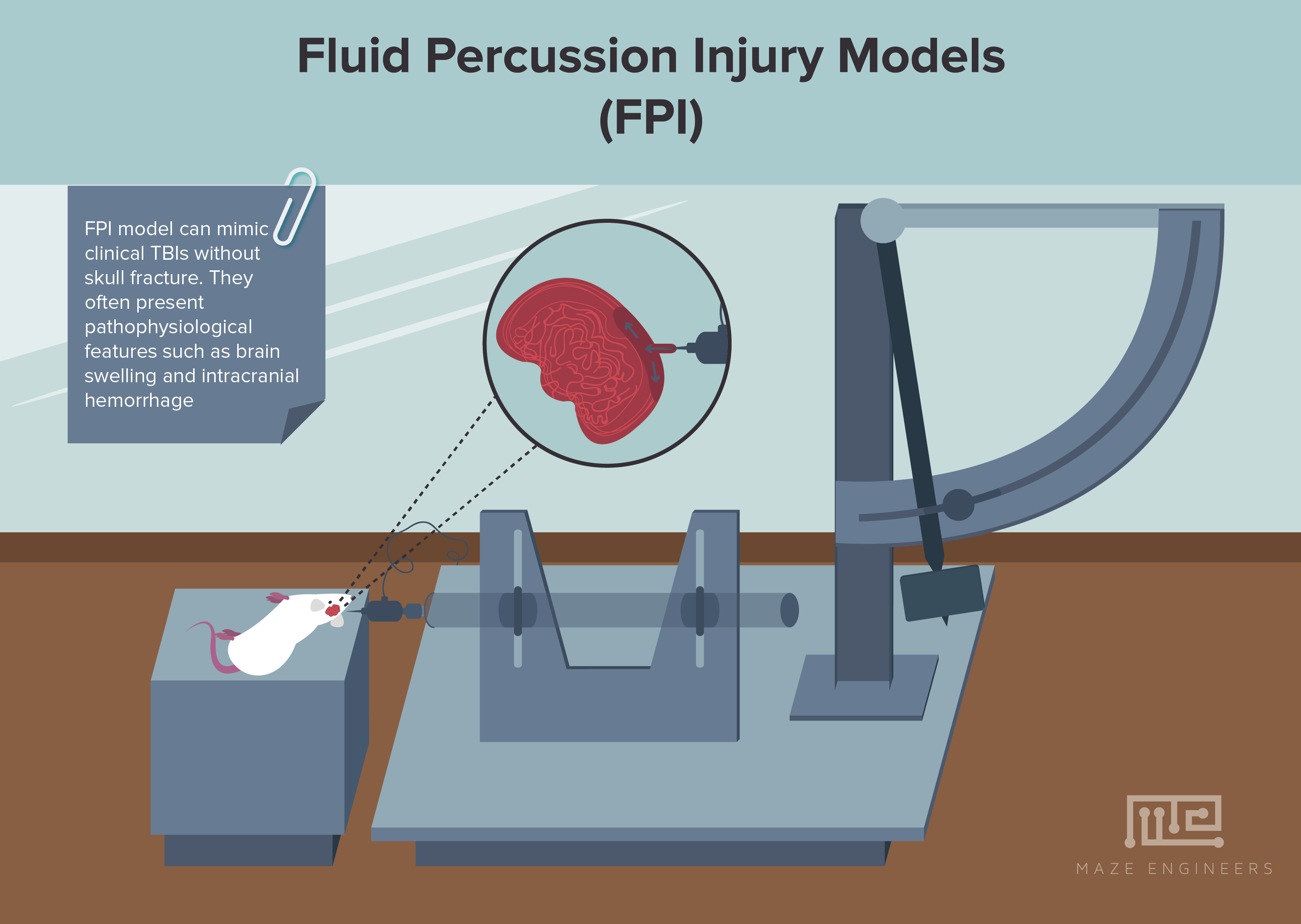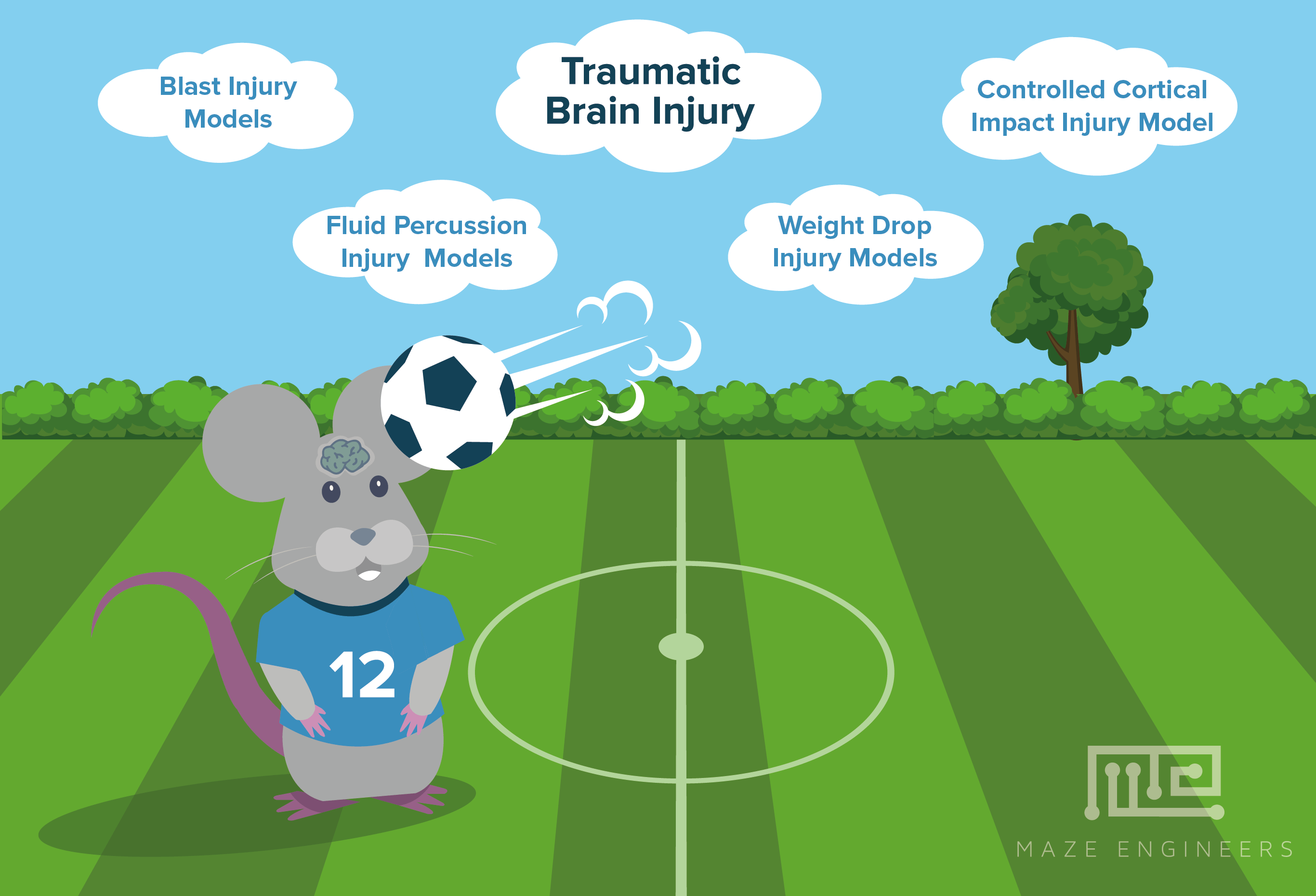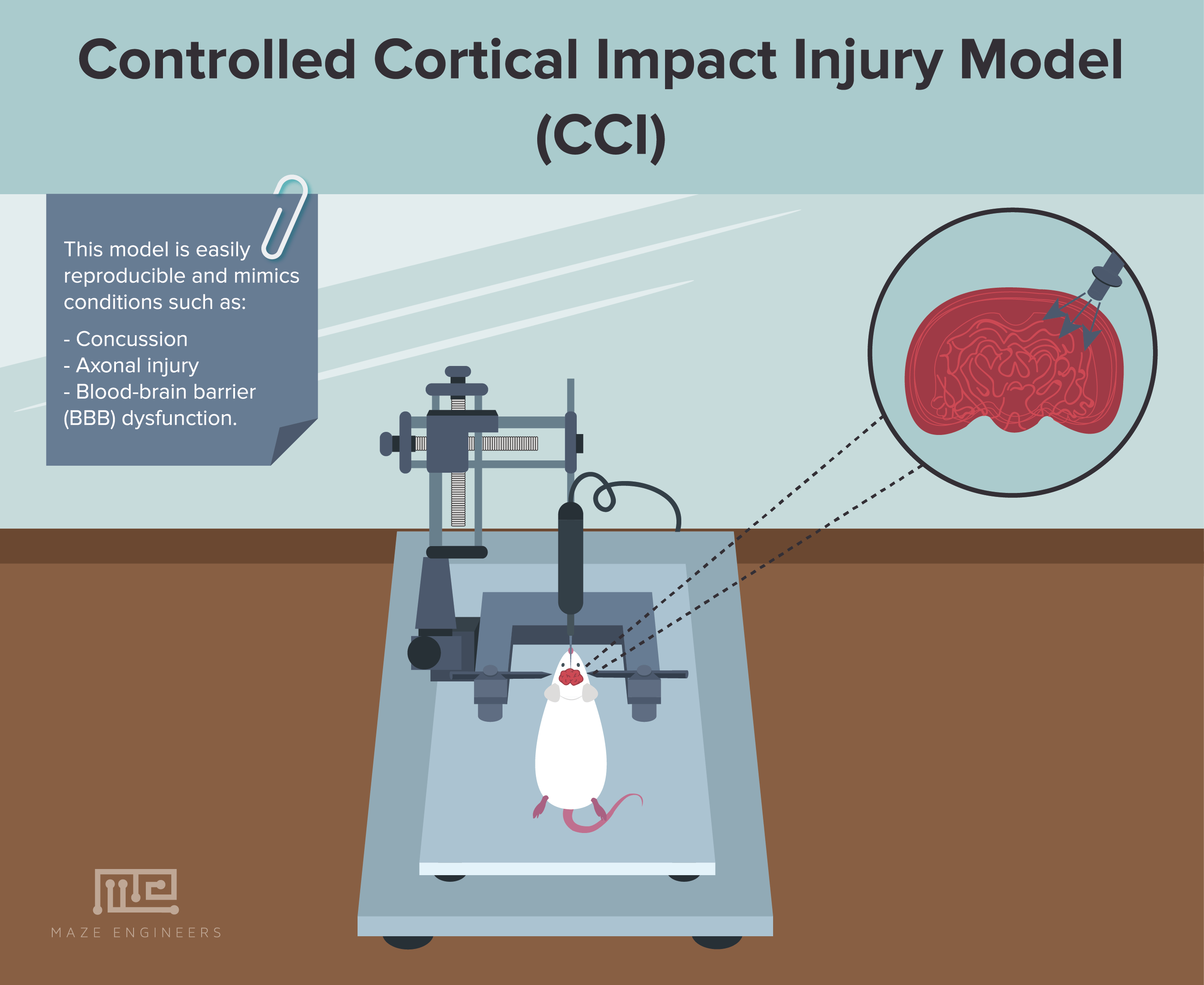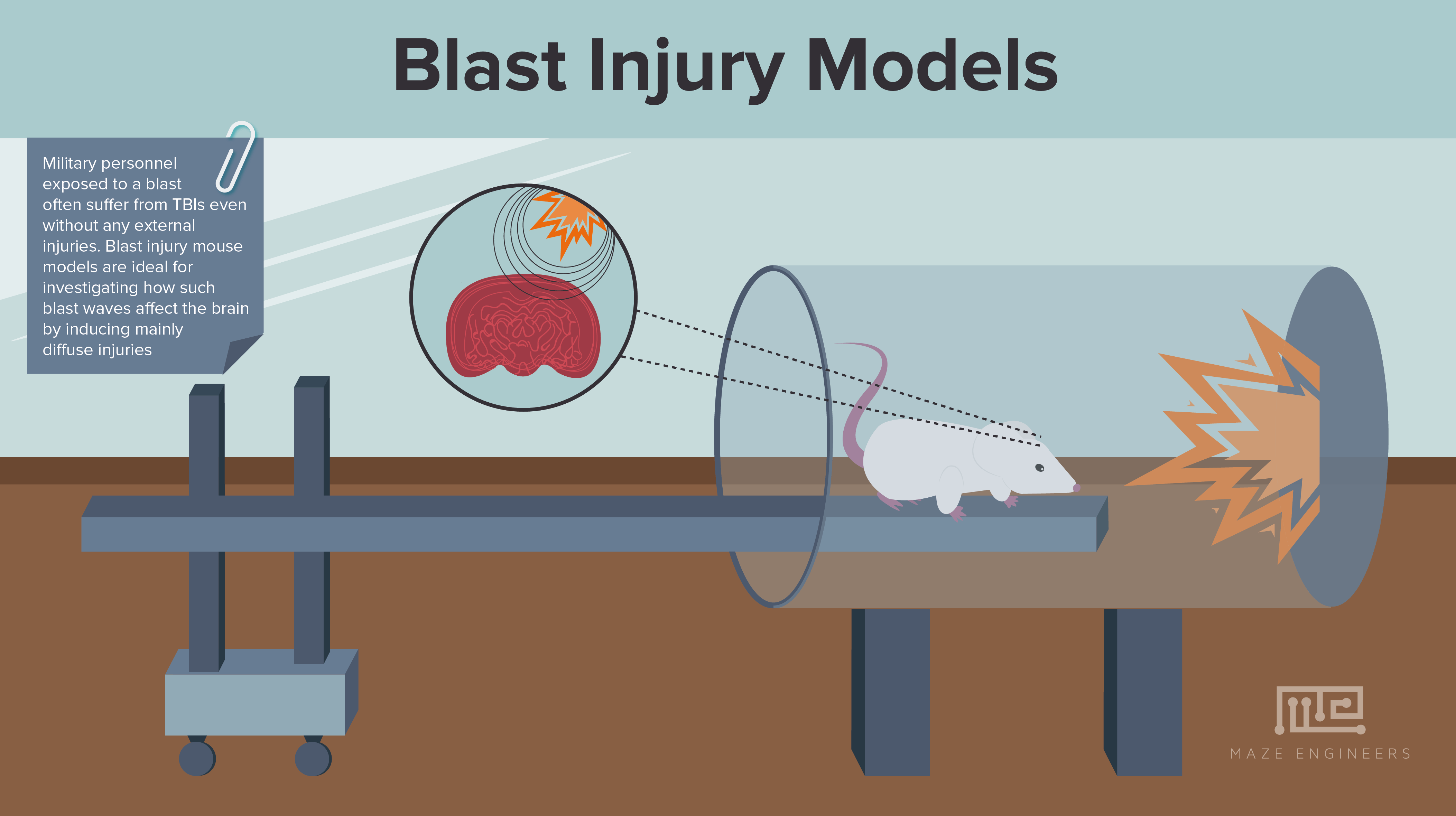Traumatic brain injury (TBI) is a major cause of disability affecting millions in the US yearly, with survivors often suffering from changed personalities, cognition and sensorimotor functions. However, many challenges remain when trying to translate findings from animal studies to direct patient care. This emphasizes the need to reexamine current animal models of Traumatic Brain Injury in the exploration for feasible clinical treatments in the future.
Here, we provide an overview of some common animal models of Traumatic Brain Injury used today as a primer for anyone interested to know more about this highly dynamic line of research.
Popular Animal Models of Traumatic Brain Injury
To set up an experimental model of TBI, the mouse first needs to be secured in a way that exposes the part of the brain we want to target.
Next, the procedure of interest simulating TBIs in real life is selected and performed:
- Controlled cortical impact injury: an air/electromagnetic driven piston is used to penetrate the brain[1]
- Weight drop TBI: a free weight is dropped onto the exposed dura[2][3]
- Fluid percussion injury: a fluid pulse is driven rapidly into the epidural space[4][5]
- Blast TBI: a blast wave e.g. from detonation is used to induce brain injury[6]
What to Consider When Picking a TBI Model
Factors which may be important in deciding which TBI model to pick include data reproducibility, how similar the injury mechanism is to humans as well as whether the model is well-characterized.
Below, we briefly summarize four popular mouse models and their experimental readouts
Controlled Cortical Impact Injury (CCI) Model
The Controlled Cortical Impact model is characterized by consistent data with specific parameters. It is a type of animal model of Traumatic Brain Injury that delivers a highly controlled focal impact to the mouse at a specific time, velocity and impact depth. This is typically done using an impactor targeted to the dura, the outermost layer of three membranes enveloping the brain.
This model is easily reproducible and mimics conditions such as concussion, axonal injury[7][8] and blood-brain barrier (BBB) dysfunction. Neuropathological damage can be widespread, involving degeneration of different brain regions such as the cortex, hippocampus and thalamus[9]. In particular, the minimal risk of rebound injury helps to increase the reliability of results obtained. However, a craniotomy (surgical opening into the skull) is needed, and this would require some degree of technical expertise.
Given how dangerous a blow to our own heads can be, it is not surprising that cognitive and emotional deficits can be found in mice suffering a Controlled Cortical Impact injury using the following tests:
- Morris Water Maze Test – cognitive impairments[10]
- Forced Swim Test – depression-like behavior[11]
- Elevated-plus Maze – anxiety-like behavior[11]
Weight Drop Injury Models
Contact sports, military activities and child abuse commonly result in mild TBIs, and such TBIs form the majority of annual TBI cases reported in the US. In the lab, weight drop Traumatic Brain Injury models in mice can be used to mimic the clinical consequences of such TBIs. This model is simple and easy to perform. Here, the skull of the mouse is exposed to a guided free falling weight – this can occur either with or without a craniotomy. The mass of the weight and height of dropping it determines how severe the injury is. Additionally, the type of injury induced depends on the type of weight drop model used:
- Shohami’s weight drop model[12]:
- Mainly focal injury
- Weight drop is delivered to one side of the unprotected skull
- Marmarou’s weight drop model[2]:
- Mainly diffuse injury
- A metal disk placed over the skull prevents bone fractures from the weight drop
Weight drop animal models of Traumatic Brain Injury are relatively cheap to set up and easy to perform, though the trade-off is a somewhat high variability in the severity of the injury.
Similar to the CCI, mild TBIs can also induce severe morphological changes in the brain as well as various degrees of neurodegeneration[2][6]. Weight drop TBIs also induce behavioral abnormalities in mice such as significantly delayed spatial learning in the Morris Water Maze Test[13][14].
Fluid Percussion Injury (FPI) Models
The Fluid Percussion Injury model mimics non fracture TBIs. A pressure pulse targeted at the intact dura via a craniotomy induces the TBI. This pulse (or “percussion”) is generated when a pendulum strikes the piston of a reservoir of fluid. Fluid percussion injuries lead to brief brain tissue displacement and deformation, and the strength of the pressure pulse and also the site of the craniotomy are the main factors determining the severity of the injury.

Fluid percussion injuries lead to brief brain tissue displacement and deformation, and the strength of the pressure pulse and also the site of the craniotomy are the main factors determining the severity of the injury. Fluid percussion injury mice can mimic clinical TBIs without skull fracture and often present pathophysiological features such as brain swelling and intracranial hemorrhage[15]. Similar to other animal models of Traumatic Brain Injury models, cognitive and motor coordination deficits have also been reported using the Morris Water Maze Test and Rotarod Behavioral Test respectively[16]. Moreover, results obtained are highly reproducible with fine-tuning of the pendulum height. Even so, the necessity of performing a craniotomy and high mortality rate would reduce the ease of data collection.
Blast Injury Models
Military personnel exposed to a blast often suffer from TBIs even without any external injuries. As such, blast injury mouse models are ideal for investigating how such blast waves affect the brain by inducing mainly diffuse injuries. This could in turn help develop treatments to mitigate blast-induced TBIs. Notably, even mild injuries from blast waves lead to spatial memory and social recognition impairments[17], and also motor coordination deficits in the Rotarod Behavioral Test in mice[18].
As with other animal models of Traumatic Brain Injury, chronic neuroinflammation and neurodegeneration are common brain pathologies observed in injured mice[6]. Unsurprisingly though, the effects of blast injury on mice are variable and tend to be different from TBIs induced mechanically at a focal point (19). For instance, where the mouse is placed along the shock tube alone greatly affects the type and severity of injury. Given the experimental variation in current blast injury models, results from this model may hence require further characterization to improve reproducibility of data and facilitate comparisons between studies.
From Bench to Bedside
To effectively progress preclinical findings to clinical treatments, a combination of therapies is often needed. This can involve creative tweaking of tests to test specific phenomena or combining existing tests with novel pharmaceutical agents – the possibilities are endless!
Comparing results from short-term and long-term studies and investigating comorbidities (inducing other types of stress e.g. hypoxia) can also contribute to improving our understanding how we can build on the existing management of TBIs.
In summation, we hope that this short article has given the reader some insight into how TBIs can be experimentally tested and applied effectively in mouse models – hit us up for more information if you are interested in working with us to develop a customized maze for your needs!
*For a detailed review on the current status of animal models of TBI, the following review is a great article to begin with!
Xiong Y, Mahmood A, Chopp M. Animal models of traumatic brain injury. Nature reviews Neuroscience. 2013;14(2):128-142.
References
- Smith DH, et al. A model of parasagittal controlled cortical impact in the mouse: cognitive and histopathologic effects. J Neurotrauma. 1995;12:169–178.
- Marmarou A, et al. A new model of diffuse brain injury in rats. Part I: Pathophysiology and biomechanics. J Neurosurg. 1994;80:291–300.
- Flierl MA, et al. Mouse closed head injury model induced by a weight-drop device. Nat Protoc. 2009;4:1328–1337.
- Carbonell WS, Maris DO, McCall T, Grady MS. Adaptation of the fluid percussion injury model to the mouse. J Neurotrauma. 1998;15:217–229.
- Alder J, Fujioka W, Lifshitz J, Crockett DP, Thakker-Varia S. Lateral fluid percussion: model of traumatic brain injury in mice. J Vis Exp. 2011
- Goldstein LE, et al. Chronic traumatic encephalopathy in blast-exposed military veterans and a blast neurotrauma mouse model. Sci Transl Med. 2012;4:134–160.
- Morales DM, et al. Experimental models of traumatic brain injury: do we really need to build a better mousetrap? Neuroscience. 2005;136:971–989.
- Lighthall JW, Goshgarian HG, Pinderski CR. Characterization of axonal injury produced by controlled cortical impact. J Neurotrauma. 1990;7:65–76.
- Hall ED, et al. Spatial and temporal characteristics of neurodegeneration after controlled cortical impact in mice: more than a focal brain injury. J Neurotrauma. 2005;22:252–265.
- Fox GB, Fan L, Levasseur RA, Faden AI. Sustained sensory/motor and cognitive deficits with neuronal apoptosis following controlled cortical impact brain injury in the mouse. J Neurotrauma. 1998;15:599–614.
- Kochanek PM, et al. Cerebral blood flow at one year after controlled cortical impact in rats: assessment by magnetic resonance imaging. J Neurotrauma. 2002;19:1029–1037.
- Flierl MA, et al. Mouse closed head injury model induced by a weight-drop device. Nat Protoc. 2009;4:1328–1337.
- DeFord SM, et al. Repeated mild brain injuries result in cognitive impairment in B6C3F1 mice. J Neurotrauma. 2002;19:427–438.
- Creeley CE, Wozniak DF, Bayly PV, Olney JW, Lewis LM. Multiple episodes of mild traumatic brain injury result in impaired cognitive performance in mice. Acad Emerg Med. 2004;11:809–819.
- Graham DI, McIntosh TK, Maxwell WL, Nicoll JA. Recent advances in neurotrauma. J Neuropathol Exp Neurol. 2000;59:641–651.
- Alder J, Fujioka W, Lifshitz J, Crockett DP, Thakker-Varia S. Lateral Fluid Percussion: Model of Traumatic Brain Injury in Mice. J Vis Exp. 2011;54:3063. doi:10.3791/3063.
- Koliatsos VE, et al. A mouse model of blast injury to brain: initial pathological, neuropathological, and behavioral characterization. J Neuropathol Exp Neurol. 2011;70:399–416.
- Wang Y, et al. Tightly coupled repetitive blast-induced traumatic brain injury: development and characterization in mice. J Neurotrauma. 2011;28:2171–2183.
- Bhattacharjee Y. Neuroscience. Shell shock revisited: solving the puzzle of blast trauma. Science. 2008;319:406–408.




